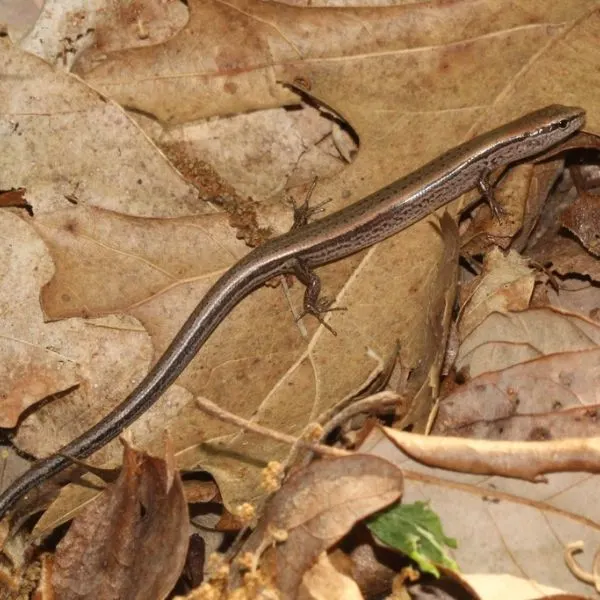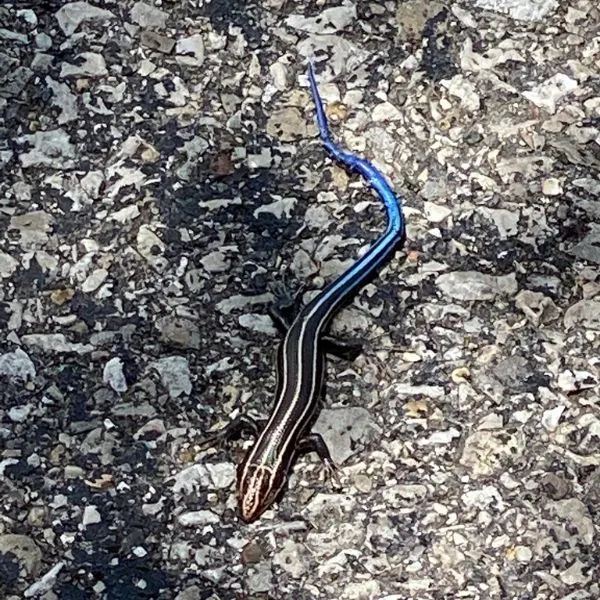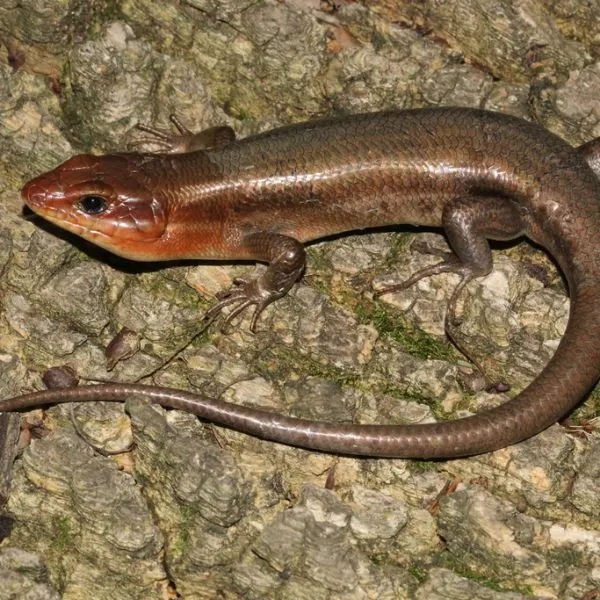There are 3 different types of skinks in Indiana. These fascinating lizards occur throughout most of the state.
At first glance, you may mistake a skink for a snake. It typically lacks a distinct head and has a long, slender body with reduced limbs. It also moves in the wavy or zigzag manner of snakes.
Unlike many snakes, however, these lizards are entirely harmless. They feed primarily on small insects and other arthropods.
So if you find some roaming in your garden, consider them biological pest controls.
Skinks are fascinating creatures. While many are skilled at hunting prey, they are pretty timid around predators. Rather than fighting, these lizards often run for shelter at the slightest sign of a threat.
When cornered or grasped, these lizards may bite. But it is also common for them to drop their tails, leaving the predator with only a piece of their body.
This tail thrashes about for a while and can distract predators from chasing them.
This guide will teach you about the different types of skinks in Indiana. By the end, you will know how to identify each species along with valuable facts about it.
Table of Contents
Skinks in Indiana
1. Ground Skink

- Experience Level: Advanced
- Family: Scincidae
- Scientific Name: Scincella lateralis
- Other Names: Little Brown Skink
- Adult Size: 3 to 5.75 inches
- Lifespan: 2 to 4 years
- Average Price Range: N/A
Ground skinks are common in most states across the US, including Indiana. Also called little brown skinks, these tiny lizards are typically coppery brown. But you may find many with gold to dark brown skins.
Little brown skinks have a broad dark stripe running from snout to tail on each side. The pattern of these lizards is consistent, regardless of age and sex. This lack of dramatic coloration change sets them apart from other skinks in Indiana.
Another feature that makes these skinks unique is that they never climb trees. Ground skinks live in moist forests with loose soil and plenty of leaf litter, rotting logs, and other debris. They spend all their time foraging and hunting under these leaves in their habitats, rarely surfacing.
They can forage effectively under debris because they have windows in their eyes. These “windows” are transparent scales they can see through even with closed eyes. Other skinks in Indiana lack this adaptation.
Because these skinks mostly travel under leaves, you might have difficulty catching them in the wild. The rustle of leaves in their habitat is often the only indication they are around. These skinks move fast, so they are usually gone when you hear the leaves rustle.
The tiny size of ground skinks makes them prey for many reptiles, including bluebirds. However, it is what discourages many people from keeping them as pets. Another reason is that they do not live long.
Little brown skinks are common in the pet trade, where they serve as food for young snakes and other carnivores. If you keep one, you can feed it with arthropods like spiders and beetles. You can also supplement with mealworms and waxworms.
2. Common Five-lined Skink

- Experience Level: Beginner to Intermediate
- Family: Scincidae
- Scientific Name: Plestiodon fasciatus
- Other Names: American Five-lined Skink, Five-lined Skink, Common Five Lined Skink
- Adult Size: 5 to 8.5 inches
- Lifespan: 6 to 10 years
- Average Price Range: N/A
Common five lined skinks have a wide range. You can find them almost anywhere, from forests to gardens or trash piles near people’s houses. Nevertheless, these lizards favor damp forests.
The natural habitat of these lizards is abundant in trees, leaf litter, and fallen logs. Common five-lined skinks mostly forage on the ground, but they are not opposed to climbing trees. They often climb trees to bask in the sun, escape non-climbing predators, or hunt.
Common five lined skinks are called so because they are the most abundant five lined skink species in North America.
Juveniles and adult females possess five dorsolateral lines running down their bodies. These lines are lighter than the rest of their backs.
Adult females have slightly darker stripes and a brown ground color. However, young five lined skinks have stunning black skins and bright blue tails. All adults lose this blue tail coloration.
Male adult five lined skinks look different. Their skins are light brown and often lack dorsolateral stripes. They also tend to have orange markings around their jaws and chins, but this color becomes more pronounced during breeding seasons.
Adult males are aggressive towards other adult males over territory or mating rights. However, they are warm towards adult females.
You can keep these skinks as pets, but they are not ideal for people who like cuddly pets. Five-lined skinks are excellent fits for display in home terrariums. However, they dislike frequent handling.
These skinks will likely run or bite when you try to pet them. Besides this, they are fine. Ensure their enclosures have ample space and plenty of vegetation. Also include basking spots and UV lighting to keep the lizard comfortable.
Make arthropods your five lined skink’s primary food. But you can also include other invertebrates like worms or fruits and vegetables in its diet.
3. Broad headed Skink

- Experience Level: Advanced
- Family: Scincidae
- Scientific Name: Plestiodon laticeps, Eumeces laticeps
- Other Names: Broadhead Scorpion, Five-lined Skink
- Adult Size: 6 to 13 inches
- Lifespan: 6 to 10 years
- Average Price Range: N/A
Broad headed skinks are another five-lined skink species. They are also the biggest skinks in Indiana.
You can find broad headed skinks in moist forest areas with hollow trees and plenty of ground leaves and fallen logs. They favor oak forests, especially those near a waterbody.
These giant lizards are the most arboreal skinks in Indiana. You will often find them basking on high tree branches in the wild. While they forage on the ground, they typically dash for trees when threatened by predators.
Broad headed skinks are sharp predators themselves. While they mostly consume insects and other arthropods, a broadhead skink will often hunt small vertebrates. Vertebrates they prey on range from other reptiles to small mammals.
You can identify a mature male broad headed skink by its enormous, orange head. It has enlarged jaws, giving the head a triangular shape. During breeding seasons, the lizard’s head brightens into reddish-orange that persists until the seasons’ end.
Adult females and young broadheads lack enlarged heads. So you will have difficulty distinguishing them from common five-lined skinks.
Young broadheads have black skin with five dorsolateral lines and a blue tail. This blue coloration disappears in adulthood, and the skin lightens brown. However, adult females retain the stripes while males do not.
Scale examination is the best way to distinguish broadheads from common five-lined skinks. Broadheads have 5 supra-labial scales and no enlarged post-labial scale. In contrast, common five-lined skinks have 4 supra-labial scales and 2 enlarged post-labial scales.
You can keep broad headed skinks in a terrarium at home for display. These lizards are easy to care for, but they can be aggressive. They dislike handling, so you should only keep one if you are comfortable not cuddling your pet.
Keep your pet broad headed skink in a damp, well-wooded enclosure. Ensure to include elevated basking spots and UV lighting.
Frequently Asked Questions
If you have recently taken an interest in the skinks in Indiana, you may have many questions about them. You will find clear answers to those questions in this section.
How do you identify skinks?
You can identify the skinks in Indiana by their smooth, glossy scales and long, streamlined bodies. These lizards have reduced but functional limbs. Except for species like adult male broadheads, they typically have indistinct heads.
How rare are skinks in Indiana?
Skinks are not rare in Indiana. You can find skinks in nearly all parts of the states. However, of the 3 skinks in Indiana, you will likely encounter five-lined skinks most frequently. That is because they have high populations and wide ranges.
What do skinks in Indiana eat?
Skinks in Indiana eat various foods. Their primary diet consists of arthropods like spiders, beetles, roaches, and crickets. However, they also eat other tiny invertebrates like worms.
You may find these lizards snacking on fruits like native grapes or blackberries in the wild. So you can add these to your pet skink’s diet. But do not make fruits its primary food.
Many skinks in Indiana also eat other vertebrates, including small lizards of their species.
Are skinks in Indiana poisonous?
No. The skinks in Indiana are not poisonous. While it is likely that the skin of some species tastes unpleasant to predators, the lizards are not poisonous.
You may hear older people in southern parts of the state refer to the two five-lined skinks in Indiana as scorpions. This name is due to the belief that blue-tailed juvenile skinks are venomous. However, this belief is unfounded.
Of course, skinks bite. But their bite contains no venom and is harmless. While it certainly hurts, even bites from large species do not cause any serious damage.
Where are skinks found in Indiana?
You can find skinks in most parts of Indiana, but each species has its geographical range. For example, common five-lined skinks are widespread all over the state. In contrast, broadhead skinks mostly range in the southern and west-central parts of Indiana.
If you are out searching for skinks in Indiana, ensure you research the range of the species you are interested in finding.
Can you own a pet skink in Indiana?
Yes. You can own pet skinks in Indiana. The state does not prohibit the possession of these wildlife species.
Wrapping up
Indiana does not have many lizard species. Of the 7 lizard species in the state, skinks account for 3. You can find them in several parts of Indiana, but they often favor damp areas.
The skinks in Indiana play a vital role in the environment. They help maintain the natural order in the ecosystem by controlling insect populations. For this same reason, they are excellent pest natural controls. So you should not harm any you see wandering in your garden.
Owning a pet skink requires commitment from you. Caring for these lizards is relatively easy, but you must provide them with the right shelter and food.
When getting a pet skink, try purchasing one from a pet store. Collecting skinks from the wild may harm them, especially if they drop their tails while trying to escape you.
Their tail eventually grows back, but it uses up plenty of their energy. It also scarcely reaches its previous length.
Another reason to get skinks from recognized pet stores is that captive-bred skinks harbor fewer parasites than wild skinks.
Skinks in other states
